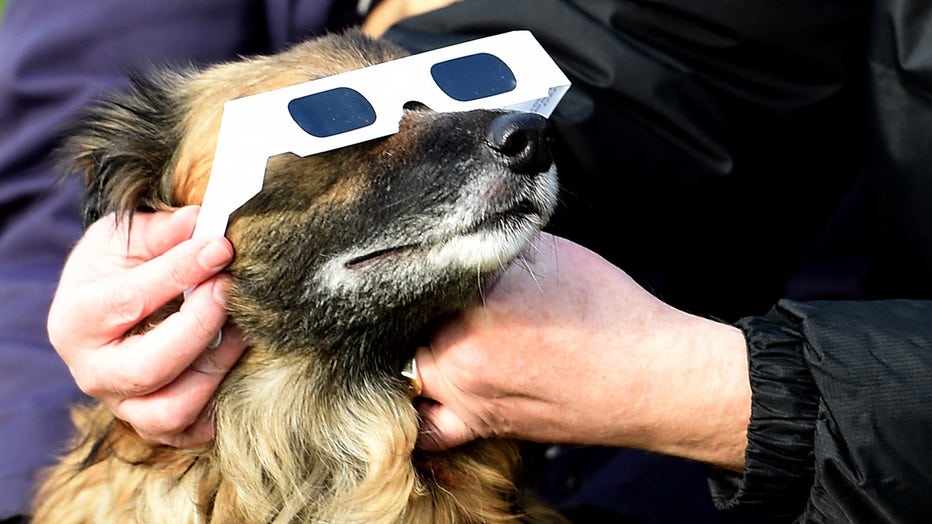Total solar eclipse: How animals react to daylight turning dark
Capturing the sounds of a solar eclipse
A NASA-sponsored study is enlisting citizen scientists to record their sounds and sites of the total solar eclipse in April to better understand how wildlife is response to the eclipse. (Video: NASA)
For a few precious minutes on April 8, 2024, darkness will descend across the United States as a historic total solar eclipse crosses a wide swath of North America.
For millions of people, daytime will briefly turn to night.
But according to scientists, humans won’t be the only ones affected and reacting to the phenomenon in the sky.
According to National Geographic, reports of unusual animal reactions to solar eclipses date back centuries. One of the earliest stories comes from Italian monk Ristoro d'Arezzo, who described what happened during a total eclipse on June 3, 1239.
"As the sun disappeared and the sky turned dark, "all the animals and birds were terrified; and the wild beasts could easily be caught," he wrote.

People use protective glasses on their dog during a partial solar eclipse. (Credit: PAUL ELLIS/AFP via Getty Images)
The Associated Press said earlier this month that researchers will also be standing by to observe how animals’ routines at the Fort Worth Zoo in Texas are disrupted when the skies dim on April 8. They previously detected other strange animal behaviors in 2017 at a South Carolina zoo that was in the path of total darkness.
"To our astonishment, most of the animals did surprising things," Adam Hartstone-Rose, a North Carolina State University researcher who led the observations published in the journal Animals, told AP.
Seven years ago, Galapagos tortoises at the Riverbanks Zoo in Columbia, South Carolina, "that generally do absolutely nothing all day … during the peak of the eclipse, they all started breeding," said Hartstone-Rose. The cause of the behavior is still unclear.
A mated pair of Siamangs, gibbons that usually call to each other in the morning, also sang unusual tunes during the afternoon eclipse. A few male giraffes began to gallop in "apparent anxiety." The flamingos huddled around their juveniles.
Eye protection for April's total solar eclipse
If you’re among the millions of people who will get the chance to witness April’s total solar eclipse, you’re going to want to use eye protection. Vitreoretinal surgeon at New York Eye and Ear Infirmary of Mount Sinai Dr. Avnish Deobhakta joined FOX Weather on Sunday to explain the dangers of viewing the eclipse without proper eye protection.
Researchers said that many animals display behaviors connected with an early dusk.
Several other zoos along the path are also inviting visitors to help track animals, including zoos in Little Rock, Arkansas; Toledo, Ohio; and Indianapolis.
"It’s really high stakes. We have a really short period to observe them and we can’t repeat the experiment," said Jennifer Tsuruda, a University of Tennessee entomologist who observed honeybee colonies during the 2017 eclipse.
The honeybees that Tsuruda studied decreased foraging during the eclipse, as they usually would at night, except for those from the hungriest hives.
When is the total solar eclipse 2024?
The total solar eclipse will occur on April 8, 2024 at around 1:27 p.m. CDT time and end around 3:35 p.m. EDT time.
What is the path for total solar eclipse?
The path of totality, where the moon will completely block out the sun, will be 115 miles wide and cut diagonally across the country.
RELATED: The April solar eclipse is one month away: What to know now
The moon’s shadow will move across Mexico, then enter the United States west of San Antonio at around 1:27 p.m. local time, crossing Austin and Dallas. From there, it cuts northeast through parts of Oklahoma, Arkansas, Missouri, Kentucky, Illinois, Indiana, and Ohio, then the northern portions of Pennsylvania, New York, Vermont, New Hampshire and Maine. Small parts of Tennessee and Michigan will also see a total solar eclipse.
What will I see during total solar eclipse?
If you are in that path of totality: The moon will appear to completely block the sun for as long as seven and a half minutes. Daytime will turn into near night during that time and the sun’s corona – the outer rays – may be visible.
If you are not far from the path of totality: The moon will appear to block most of the sun. It will still become noticeably darker; daylight will become more like twilight.
If you are well outside the path of totality: You’ll notice a chunk of the sun is being blocked. The farther away you are, the smaller the moon’s bite will appear to be. In Seattle and Portland, Oregon, about as far away as you can get in the continental U.S., one-third of the sun will be swallowed.
This story was reported from Los Angeles. The Associated Press contributed.

